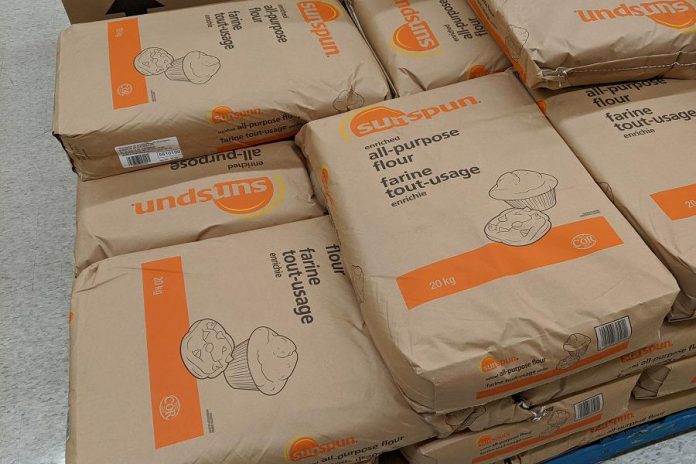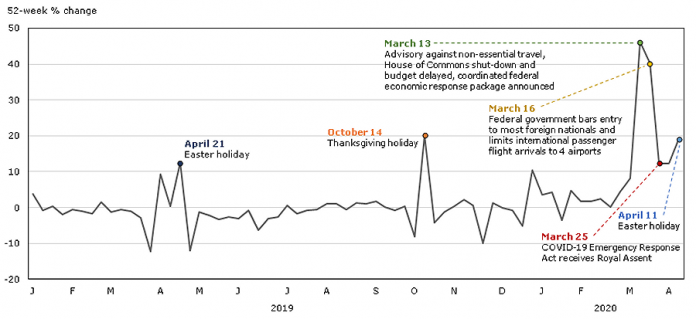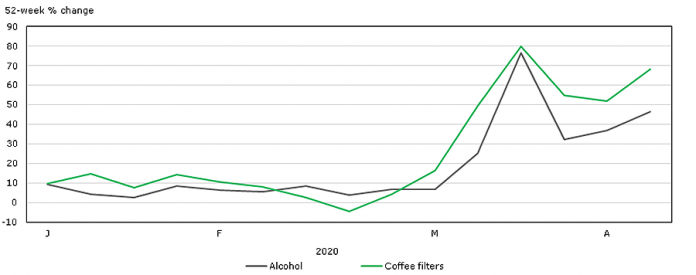
Hand sanitizer, flour, alcohol, coffee filters, hair dye … and condoms.
These are some of the products that saw record increases in sales at Canadian grocery stores during March and early April, according to a new study released by Statistics Canada on Monday (May 11).
On the other hand, cut flowers, cosmetics, and hair styling and cutting supplies saw a drop in sales.
Canadian Consumers Adapt to COVID-19: A Look at Canadian Grocery Sales up to April 11 is a follow-up study to Canadian Consumers Prepare for COVID-19, a similar study released by Statistics Canada in early April.
The April study had found a surge in grocery store sales in March, with the biggest increase in sales in hand sanitizers (up 792 per cent over the previous year) and masks and gloves (up 377 per cent). Personal cleaning products also saw a dramatic increase in sales, with facial tissues up 253 per cent, bathroom tissue up 241 per cent, personal wipes up 231 per cent, and paper towels up 187 per cent from 2019.
The April study also found that Canadians were busy stocking up their pantries in March with shelf-stable products, with sales of rice up 239 per cent over the same period in 2019, pasta up 205 per cent, canned vegetables up 180 per cent, flour up 179 per cent, and canned fish, meat, and seafood up 169 per cent.

While staples such as eggs, butter, and bread also increased in the second week of March, along with fresh foods including potatoes and meat, sales for perishables increased by much less than dry and canned goods.
Statistic Canada’s most recent study finds that, by early April, the sales of many health and personal care items had slowed. While hand sanitizer sales were still high, they had dropped from 792 per cent over the previous year to 345 per cent.
Interestingly, while sales of cold remedies surged 226 per cent over the previous year in early March, by April their sales had returned to pre-pandemic levels. It’s possible Canadians initially scooped up cold remedies believing they would help with COVID-19.
Sales for household paper products also slowed in the first weeks of April, although they still remained higher than last year — reflecting the number of Canadians sheltering at home. People are doing their “business” at home rather than at work and school.
By April 11th, sales of shelf-stable foods had returned closed to pre-pandemic levels, with one notable exception. Flour sales, which peaked at 200 per cent in March, continued to exceed last year’s sales at 81 per cent over the previous year.
Canadians busy with pandemic baking also purchased more butter and margarine (18 per cent more than last year), eggs (44 per cent more than last year), and milk (21 per cent more than last year) — although the increase in milk sales may have more to do with cereal sales, which are up 70 per cent over 2019.
In the week leading up to Easter, cut flowers and chocolate usually see rising sales. This year though, the sales of cut flower in grocery stores fell 47 per cent over last year, while chocolate sales only rose by one per cent.

With the closure of bars and restaurants, Canadians have been drinking more at home. In provinces where beer and wine are available from grocery stores, Canadians purchased alcohol for home consumption at levels notably higher than in 2019, peaking at an 80 per cent increase by the third week of March. By April 11th, alcohol sales in grocery stores were still at 68 per cent higher than last year.
Not surprisingly, with people out of work or working from home and with less access to coffee shops, the sales of coffee filter increased 68 per cent compared to the same period in 2019.
With the closure of hair salons, sales of hair colouring products had increased to 75 per cent over last year by April 11th. But, while people weren’t willing to let their hair go grey, they were willing to do without makeup. By the end of March, the sales of cosmetics had dropped by 44 per cent. Sales picked up a bit in April, but were still 33 per cent lower than the same time last year.
People were also willing to let their hair grow longer, but only to a point. Hair styling and cutting supplies fell by 35 per cent in March but, two weeks later, rose again by 17 per cent.
Finally, Canadians apparently were initially concerned about a pandemic baby boom. By the third week of March, sales of family planning products including condoms and contraceptives had risen to 41 per cent over the same time last year.
However, by the end of March and early April, sales dropped back to normal levels — perhaps because Canadians found themselves with more family planning products they could use despite the lockdown (or they were too busy baking).


























